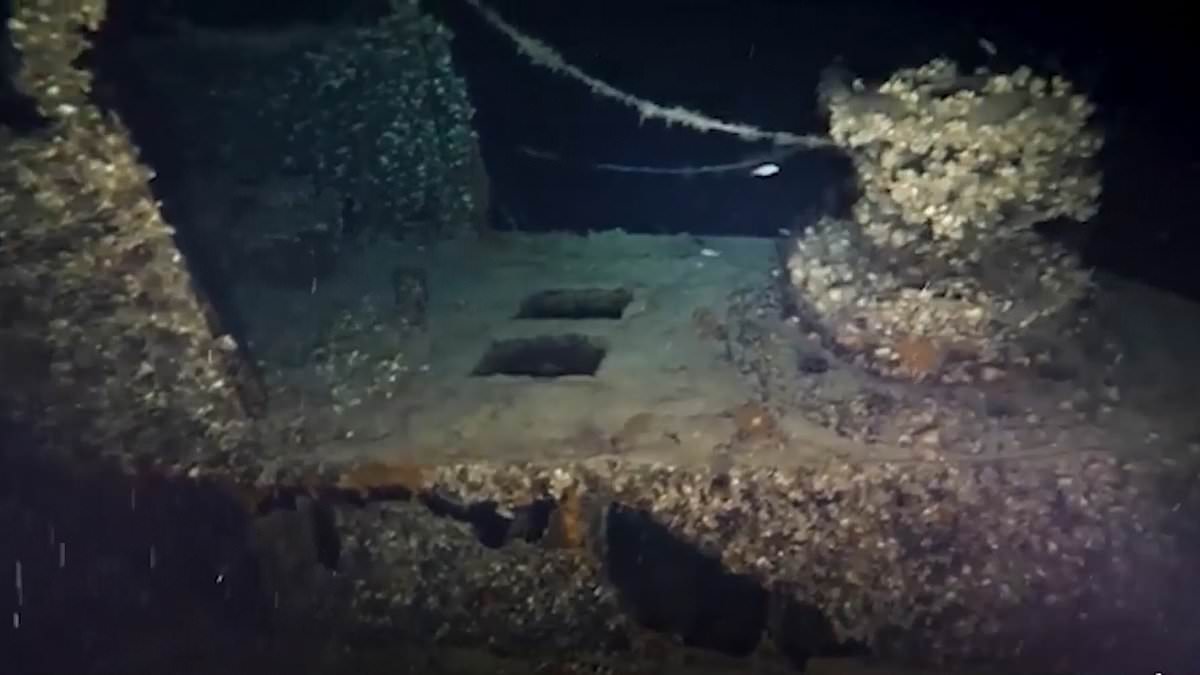A British World War II submarine that disappeared with 64 crew members on board during a secret mission in 1943 has been found off Greece.
The wreck of HMS Trooper has been discovered 830ft below water by a private deep sea research company, solving the 81-year mystery over its whereabouts.
The 275ft-long submarine is cut into three distinct sections, the owner of Planet Blue, the firm that found the vessel, told Greek media.
Costas Thoktaridis said the separation of the bow, middle section and stern confirms HMS Trooper suffered a very violent sinking following a mine explosion.
The discovery of the wreck is hoped to finally bring some closure to the families of the submarine’s crew, which included British submariners and n volunteer Lt. John Stuart Ryder, 22.

HMS Trooper was discovered by a Greek deep sea search team

Eerie pictures show fish circling around the barnacle-covered wreckage of the sub

Submariners on board HMS Trooper in a picture dated February 4 1943

Archive image shows British Royal Navy Submarine HMS Trooper at sea, date not given
Richard Wraith CBE, a captain in the Royal Navy and son of the captain of HMS Trooper said of the news: ‘I have known for many years the painstaking effort of the search team to locate the wreck of the submarine and now I am very pleased and excited that their efforts were rewarded.
‘I hope that the family members of those lost along with my father will be able to use the Trooper’s definitive status as a reference point to help lay their loved ones’ memories to rest.’
George Malcolmson, former director of the British Royal Navy’s Archive of the Royal Submarine Museum told Greek news agency ANA-MPA that he was ‘very moved’ to hear that Thoktaridis and his team had solved the decades-long mystery.
HMS Trooper launched in October 1943 for a patrol mission between Donoussa islet and Ikaria after British intelligence received information that the Nazis could attempt a new landing in Leros.

A memo reporting that the Trooper had failed to answer signals on October 17 1943 while patrolling west of Dodecanese. Mines were thought to be the probable cause of the sinking

A diagram of the British war submarine HMS Trooper, which is 275ft-long and cut into three sections, the firm who discovered it confirmed
The previous month it was tasked with transporting three secret agents and valuable cargo to the island of Euboea, the Greek newspaper Protothema reported.
The sub was ordered to return to the port of Beirut on October 17, but failed to surface and was reported missing.
A memo sent on October 20 presumed the vessel lost after it failed to answer signals
It was presumed that it had been struck by a German mine in the Aegean, most likely near Leros.
Pictures later appeared to show that the submarine had entered one of five minefields set days earlier by the German mine-sweeper ‘Drache’.
Efforts to locate the missing sub began in 2000, but more than 14 searches around the Dodecanese failed.
Searches for its remains were focused in the known German minefields of Leros, Kalymnos and Kos.
Ten sea minefields were searched without finding any trace of the HMS Trooper.
It was eventually located between Ikaria and Kos, where it is believed to have been destroyed by a mine laid a few days prior by the German mine-sweeper ‘Drache’ containing around 350kg of hexanite, a mixture of ammonium nitrate and trinitrotoluene.


It was eventually located between Ikaria and Kos, where it is believed to have been destroyed by a mine
Researchers who filmed the wreckage said they did not disturb the sub, as it serves as the final resting place of the 64 servicemen who lost their lives that day.
Pictures show the submarine, discovered at a depth of 253 metres in the Ilkarian Sea, cut into the bow, middle section and the stern, the latter which was found in the best condition.
The wreck’e exact location was pinpointed using dual-broadcast sonar CHIRP technology, before it was identified by a remotely operated underwater (ROV) vehicle.
Its turret was found detached from the rest of the wreckage. Its hatch was found half open while its gun was missing from the base.
